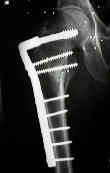 - See: proximal femoral shaft fractures /
- See: proximal femoral shaft fractures /
- Discussion:
- definition:
- between lesser trochanter and 5 cm distal, even as far as center of isthmus of the femoral shaft;
- technically starts below the lesser tuberosity;
- medial and posteromedial cortex is a site of high compressive forces, while lateral cortex experiences high
tensile stresses (forces acting on hip)
- anatomy and factors in healing
- mechanism and displacing forces:
- high trauma (young pts) vs minor fall (older pts)
- note 25% one year mortality rate in elderly patients;
- ref: Trochanteric-entry long cephalomedullary nailing of subtrochanteric fractures caused by low-energy trauma.
- pathologic frx second to metastatic disease (older pts);
- may appear independently of or w/ intertrochanteric frx;
- subtroch frxs are displaced by muscle forces attached to each frx fragment;
- thigh muscles produce shortening and varus;
- psoas attachment pulls lesser troch proximally & anteriorly;
- classifaction and frx stability:
- internal fixation for proximal femur frx counteracts deforming forces;
- successful treatment restores medial cortex by secondary bone healing w/ callus, by exact reduction of frx fragments
followed by secure healing, or by medial bone grafting w/ subsequent consolidation;
- when the medial cortex is reconstituted, a lateral plate acts as tension band and is subjected to a bending load;
- references:
- Subtrochanteric femoral fractures: influence of patient age on fracture type and mobility
- Treatment Options:
- intramedullary nailing for subtrochanteric frx
- other options:
- sliding screw fixation in subtroch frx
- references:
- Low-energy subtrochanteric fractures in elderly patients: results of fixation with the sliding screw plate.
- Trochanteric fractures. Mobility, complications, and mortality in 607 cases treated with the sliding-screw technique.
- Treatment of subtrochanteric fractures. A comparison of the Gamma nail and the dynamic hip screw: short-term outcome in 58 patients.
- AO 95 deg condylar screw / blade plate
- proximal locking plate:
- references:
- High failure rate of trochanteric fracture osteosynthesis with proximal femoral locking compression plate.
- Unstable Proximal Femur Fractures Treated With Proximal Femoral Locking Plates: A Retrospective, Multicenter Study of 111 Cases.
- positioning:
- if the reduction looks challenging, then consider the lateral position over the fracture table;
- lateral position allows free motion of the thigh and knee joint which is often required for anatomic reduction, and lateral
position facilitates posterior exposure of the femur (which is often necessary);
- reduction:
- absolute muscle relaxation (paralysis) may assist with reduction;
- determine if fracture fragments are amenable to lag screw fixation prior to plate application;
- this may convert a complex mult-part frx to a more simple 2 or 3 part frx;
- if lesser troch is still attached to proximal fragment, psoas becomes deforming force causing flexion and external rotation
of proximal fragment;
- 90 to 90 position aligns distal fragment;
- abduction of distal fragment may be needed to compensate for hip abductor force on the proximal frag;
- references:
- Functional and radiographic outcomes of intertrochanteric hip fractures treated with calcar reduction, compression, and trochanteric entry nailing.
- Challenges in Subtrochanteric Femur Fracture Management
- bone grafting:
- see: bone graft harvest technique:
- frx w/o anatomic reduction & w/ medial gap;
- frxs treated by closed IM Nailing w/ locked nail are not bone grafted thru an open incision;
- bone grafting is performed by packing reamings of femoral canal thru chest tube inserted over guide wire down to the level
of fracture is done in all such cases;
- Postoperative Care:
- initiation of wt bearing to soon postoperatively to be one of major causes of fracture healing complications;
- frxs w/ medial or segmental comminution must be protected, regardless of device used, for at least 6-8 weeks until early healing is
radiographically evident;
- touch down wt bearing is allowed for 6-8 weeks when compression hip screw is used; (w/ sig comminution upto 12 wks of non wt
bearing is required);
- full wt bearing is allowed when there is x-ray evidence of healing;
- progression to full wt bearing is allowed w/in limits of pain
- references:
- Postoperative improvement of walking capacity in patients with trochanteric hip fracture: a prospective analysis 3 and 6 months after surgery.
References:
Treatment of unstable intertrochanteric and subtrochanteric fractures in elderly patients. Primary bipolar arthroplasty compared with internal fixation.
Early versus delayed stabilization of femoral fractures. A prospective randomized study.
Unstable intertrochanteric/subtrochanteric fractures of the femur.
Biologic plating versus intramedullary nailing for comminuted subtrochanteric fractures in young adults: a prospective, randomized study of 66 cases.


